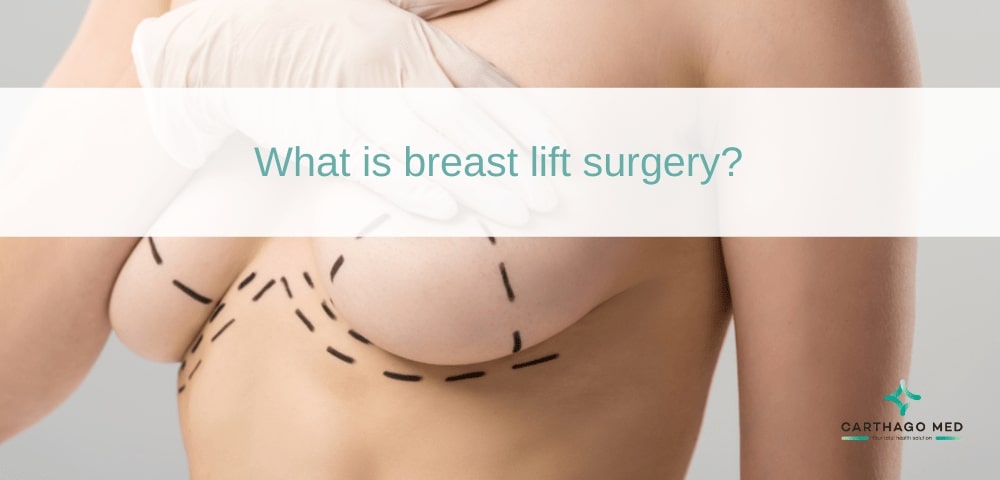
What is breast lift surgery?
What is a mastopexy?
A breast lift, also known as mastopexy, is a surgical procedure that corrects breast ptosis while restoring a harmonious shape to the patient’s breasts. Breast ptosis is the drooping of the breasts, which can be caused by significant weight loss or after several pregnancies. Mastopexy requires separating the excess skin volume from the breast tissue that has become insufficient to fill it. The breast tissue must then be lifted and the excess skin removed. It is possible to combine a breast lift with implants for women who are not satisfied with the volume of their breasts and who also have significant breast ptosis. If the patient does not wish to have implants, it is possible to combine a breast lift with lipofilling (injection of the patient’s own fat into the breast).
Why do people get breast lift surgery?
People opt for breast lift surgery for various reasons. Sagging boobs and dissatisfaction with the appearance of breasts can lead individuals to consider a boob lift or mastopexy. Pregnancy, breastfeeding, gravity, and aging can all contribute to breast elasticity, causing breasts to lose their firmness and shape. Breast lift surgery helps in achieving firmer tits, correcting saggy breast issues, and restoring confidence.
Additionally, individuals with concerns about breast asymmetry or those seeking to reduce the size of their areola might consider a breast uplift. For some, a breast lift can be part of a larger transformation, involving procedures like breast reduction and lift or breast uplift and implant. Breast lift surgery is also a popular choice for those looking to improve their physical appearance. The procedure often involves removing excess skin, reshaping breast tissues, and repositioning the nipples and areolas. Through techniques like breast lift mastopexy, surgeons can create a more desirable breast contour.
What happens before breast lift surgery?
Before undergoing breast lift surgery, several important steps are taken to ensure a safe and successful procedure. Patients meet with a qualified plastic surgeon to discuss their goals and medical history, including any previous surgeries and family history of breast cancer. The surgeon evaluates factors like sagging boobs, breast appearance, and breast elasticity to determine the most suitable approach for the surgery. The patient is educated about the procedure, potential risks, and expected outcomes. Additionally, pre-operative tests, including blood work and mammograms, are conducted. It’s essential for the patient to maintain a healthy lifestyle, avoid smoking, drinking alcohol at least 2 weeks before the operation, avoid taking certain medications such as aspirin, etc and adhere to any pre-surgical guidelines provided by the medical team.
What are breast lift techniques?
When considering a breast lift procedure, individuals have the option to choose from three primary techniques. The selection of the appropriate technique is contingent upon both the surgeon’s recommendation and the extent of breast sagging. The first technique involves an incision made around the areola, encircling the nipple. The second method combines an areolar incision with a vertical incision that extends from the nipple down to the breast fold. Lastly, the third technique, known as the inverted T incision, is utilized in specific cases. Each approach is tailored to address varying degrees of breast sagging, allowing for personalized and effective surgical solutions.
What happens during mastopexy?
The breast lift is a surgical operation performed under general anesthesia. It requires a 24-hour hospital stay. The operation lasts between 1 hour 30 and 2 hours on average. If the surgeon performs an additional operation (prosthesis, breast reduction, …), the breast lift operation may take a little longer. Surgeons use absorbable sutures for the sutures. You will not have to remove them.The cure of breast ptosis requires gestures that can resemble those of a breast reduction: it is to raise the mammary gland and remove the excess skin. To do this, the plastic surgeon draws the outline of the remaining part of the breast after the operation on the awake patient. Then the skin around the areola is removed and the nipple is lifted. The last step is to remove the excess skin and mammary gland to give a round shape to the breast.

What do breast lift scars look like?
One common concern among individuals considering breast lift surgery is the appearance of scars. The location and extent of scars depend on the specific technique used by the surgeon. Typically, breast lift scars are strategically placed around the areola, vertically down from the areola to the breast crease, and sometimes horizontally along the breast crease. Often appearing unevenly. These bruises tend to last for a few weeks, usually around 15 to 21 days., although their visibility varies from person to person.
What happens after breast lift surgery?
After a breast lift or mastopexy, a suction drainage system is usually put in place to reduce the risk of hematoma. It is usually kept for 24 hours, depending on its production. The breast dressing is removed the day after the procedure. A light dressing will be applied and you will have to wear the non-wired bra prescribed preoperatively. It must be worn day and night for about a month. Hospitalization for breast lift lasts between 1 and 2 days and it is recommended that someone keep you back home. After a breast lift, there is no thread to remove, the sutures are completely absorbable. The first shower after a mastopexy is allowed the day after the removal of the drains.
After undergoing breast ptosis treatment, it is common to experience several post-operative changes in the first weeks or months. One of the noticeable effects is the swelling of the breasts, which can be asymmetrical and of varying sizes. This swelling typically subsides within the initial weeks but may persist for a month or even longer in some cases. Furthermore, some degree of breast pain is to be expected, although it is usually moderate and can be effectively managed with painkillers. To ensure ongoing breast health, it is recommended to undergo a reference mammogram a few months after the surgery. This proactive measure helps in mon
What are the risks of a breast lift procedure?
Undergoing a breast lift, like any surgical procedure, comes with its share of risks. One potential risk is thrombo-embolic accidents, such as phlebitis or pulmonary embolism, which can be mitigated by wearing anti-thrombosis stockings. Bleeding from the operated area is another concern, as it may lead to complications. Necrosis of the areolas, whether total or partial, is a possibility, especially for individuals who smoke or are obese. Smoking permanently alters capillary circulation, increasing the risk of this complication, often resulting in noticeable scars. In cases of total loss of the areolas, surgical reconstruction is considered after complete healing, which can be a lengthy process requiring extensive daily dressings for several weeks or even months.
Infections, although rare, can occur and might necessitate surgical drainage under general anesthesia. Changes in sensitivity, such as numbness or unusual sensations in the areolas and nipples, are common after the surgery. While these changes often fade with time, they can also become permanent. Scarring, a natural outcome of surgery, can sometimes be larger or hypertrophic in an unpredictable manner. Surgical correction or corticosteroid injections may be required for large or hypertrophic scars. Early disunion of the scars is another potential complication, requiring medical attention. Additionally, imperfections in the final result are possible, including asymmetry or insufficient correction. In such cases, a surgical touch-up might be necessary several months after the initial procedure to achieve the desired outcome.
What Are the Outcomes and Considerations of Breast Lift Surgery?
The final results of breast lift, before and after surgery, are visible after a minimum of 3 to 6 months. The majority of patients are very satisfied with this operation. The breast has a much more harmonious shape, a plumped up breast, less flabby and firmer and with a very natural appearance. In addition, in the case of existing breast asymmetry associated with ptosis, it could be corrected and thus regain symmetry of the two breasts. However, it is important to keep in mind that breast lift surgery can leave some scars that take time to fade. It is therefore essential to be careful to limit sun exposure as much as possible during the first year.









